Tumi Fine Peruvian Cuisine
 | |
| Aji Rocoto, Canca, Aji Verde | Dominic Armato |
Call it a hunch, but something tells me the story behind Phoenix's Peruvian restaurant scene would make a good soap opera.
Upon arriving here nearly three years ago(!), I was both surprised and delighted to see just how many Peruvian restaurants there were around town. It's such a vibrant, exciting cuisine, and I'd never been in a city with so many places to explore -- Rincon Peruano, El Farol, Inca's Peruvian Cuisine, Villa Peru, Inka Fest, Contigo Peru, the mysterious weekend menu at Darwin's, and now Tumi Fine Peruvian Cuisine... did I miss any? On first glance, it seems like a stunning array of Peruvian restaurants to choose from. Of course, then it turns out that Walter Salazar, who's currently heading up the kitchen at Villa Peru, used to be the chef at the original Inca's down in Tempe. Meanwhile, Oscar Graham leaves the kitchen at Contigo Peru, helps get Inka Fest off the ground, then shortly thereafter departs Inka Fest and opens his own restaurant, Tumi. I fully expect we'll eventually learn that El Farol is run by Graham's brother-in-law and Rincon Peruano is owned by Salazar's college roommate, right before the surprise reveal that Graham and Salazar are actually fraternal twins whose long lost sister just leased a restaurant space in Glendale. Point being, there's an abundance of good Peruvian in town, even if the chart of who's working where and when looks almost incestuous at times.
So there was a big shakeup this weekend -- a extremely sad one, at that -- when Contigo Peru closed their doors. Contigo had been my runaway favorite of the crowd, and for me this is one of the most painful restaurant closings of recent memory. But after all of the requisite wailing and gnashing of teeth, the news of Contigo's imminent demise sent me scurrying back to resample some of the others, and to get a couple of good passes at Tumi to see if Graham's new kitchen stands up to his old one. And the answer is... sort of?
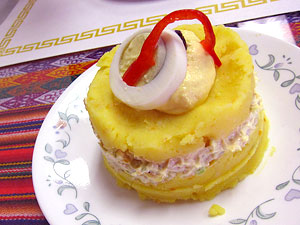 |
||
| Causa de Pollo | Dominic Armato | |
For the uninitiated, since I haven't sung its praises in, oh, seventeen minutes or so, Peruvian is all kinds of fabulous, a natural fusion cuisine borne of a diverse immigrant population that draws influences from Andean, Spanish, Chinese, African, Japanese, Italian and more. And what's remarkable, even beyond the food's sophistication and exciting flavors, is how quickly and seamlessly these influences have all been integrated and adapted to local ingredients like corn, potatoes and chiles to produce dishes that are completely unique, yet seem oddly familiar to fans of the world's great cuisines. We keep hearing year in and year out that Peruvian is going to be the Next Big Thing, and those of us who love it keep lamenting year in and year out that it doesn't quite catch fire in the American public's consciousness. Arguably, the closest we've come, even though most of us don't even know it, is the success of Nobu Matsuhisa, whose fresh, vibrant, citrus heavy sashimi dishes with accents like onion salsas, cilantro and rocoto chiles made him the standard bearer for neo-Japanese in America for the better part of a decade. His food may be chiefly Japanese, but so many of those signature creative touches are courtesy of the years he spent running a sushi restaurant in Lima before moving to the United States. When Peruvian hits the big time -- and it's bound to eventually -- it'll be tremendously overdue. So in this much, Phoenix can proudly brag that it's ahead of the curve, even if Contigo's closure is a not insubstantial step backwards. But thankfully, Tumi is there to pick up the slack, for the most part.
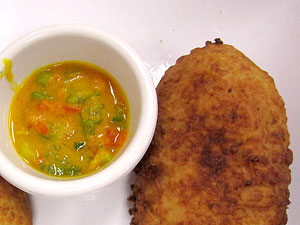 |
||
| Papa Rellena | Dominic Armato | |
Tumi is tiny -- a small fraction of the size of either of Graham's previous dining rooms -- and would be bursting at the seams if 15 people all dropped in to eat at once. But the menu's diverse, the food is solid, and here's hoping that's a fate that befalls it with more and more frequency. Right when you're seated, cancha are placed on the table along with a little bit of aji rocoto and aji verde. Cancha are corn kernels toasted in oil until they take on a deep color and a satisfying crunch, reminiscent of corn nuts, but with a nutty, salty, natural beauty that no amount of artificial enhancement can replicate. The aji rocoto and aji verde are essentially table salsas, the former ruddy with a nice kick composed of, I suspect, little more than the chiles themselves. The aji verde is a more complex construction, anchored by the vaguely mint-like huacatay, a Peruvian herb for which I'd really like to know their source. I can't hit a Peruvian joint without ordering a glass (if not a pitcher) of Chicha Morada, a drink derived primarily from purple corn, often mixed with pineapple or apple juice and scented with cinnamon and cloves. Tumi's is perfect, cool and refreshing with just a bit of spice, and not so much sugar that it starts to get sticky.
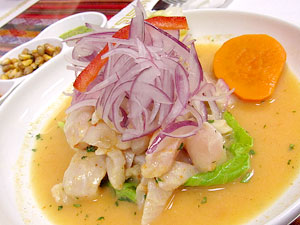 |
||
| Ceviche de Pescado | Dominic Armato | |
Causa de Pollo seems an unholy marriage at first, but is remarkably satisfying, a mayonnaise-based chicken salad -- one that would be equally at home between two slices of white bread -- layered with mashed potatoes seasoned with lime and possessing a good amount of zip, courtesy of aji amarillo, another chile native to Peru. It's just one of many odd cross-cultural dishes that doesn't seem like it should work, but does. Papa Rellena is less of a Frankendish, and is among my favorites at Tumi. Seasoned mashed potatoes (they really like potatoes in Peru) are formed around a brilliantly delicious savory/sweet filling made with ground beef, raisins, hard boiled eggs and onions before being fried to a crisp exterior. They're served with an aji amarillo salsa that adds a great spicy, vinegary punch to an already hearty and flavorful dish.
 |
||
| Ocopa con Camaron | Dominic Armato | |
I'm always taken aback by the complexity and body of a good Peruvian ceviche, and though I wouldn't call the Ceviche de Pescado one of Tumi's strengths, it's a solid entry. A healthy portion of tilapia (can we PLEASE use something other than tilapia, people?!) is bathed and partially cured in a spicy, acidic and slightly sweet dressing before being buried in slivered onions and paired with tender slices of sweet potato. It's missing a handful of cancha, a common accoutrement, but that bit of textural contrast is conveniently already sitting on the table. I've found Tumi's ceviches to be a little on the astringent side -- too heavy on the lime, I think -- but getting a little bit of sweet potato in every bite helps the balance greatly. The Ceviche de Camaron is less successful, mostly because the shrimp are cooked before hitting the marinade. I've no doubt that shrimp cured only with citrus would be a tougher sell, but I think par-cooking them makes for a far less compelling dish.
 |
||
| Anticuchos | Dominic Armato | |
Ocopa con Camaron brings together more potatoes and more shrimp, generously bathed in a complex, lightly creamy sauce with huacatay, garlic, nuts and who knows what else. Though I'd enjoy this version if the flavors were a little bolder, it's still a tasty dish, and the shrimp are perfectly seasoned and cooked. Another old Peruvian restaurant standby is anticuchos, grilled skewers of seasoned beef heart. This is a great intro to beef heart, like strips of intensely flavored ultrasteak with a slightly springy texture. Tumi's is heavy on the seasoning, which I personally appreciate, though it's perhaps not as tender as I'd prefer. (I'm of the opinion that Villa Peru isn't the restaurant Tumi is, but the texture of their anticuchos is one place where they excel.) If tenderness meant more to you than flavor, however, you wouldn't order beef heart in the first place. Hopefully my affinity for beef heart makes it clear where my priorities lie. Consider this mild criticism, however. I really enjoy Tumi's anticuchos, served with a fiery salsa and a little bit of soothing plain corn and potato if you go overboard with it.
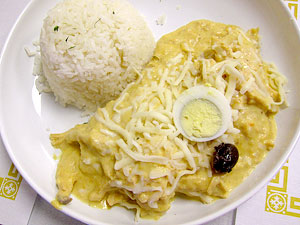 |
||
| Aji de Gallina | Dominic Armato | |
Aji de Gallina is one of my very favorite Peruvian dishes, and Tumi does it justice. Looking through recipes for Aji de Gallina is an exercise in double takes, raised eyebrow stacked upon raised eyebrow as you wonder how the hell they came up with this, and how the hell it actually works. Chicken is stewed, drained, and cooked in a creamy sauce made with onions, walnuts, white sandwich bread, parmesan cheese, evaporated milk, hard boiled eggs, garlic, aji amarillo and more. The result looks like something Lunch Lady Doris would have come up with if her father were Italian and her mother Latin, but these seemingly incongruous ingredients come together into this remarkably creamy, satisfying, comforting whole, with just enough chile zip to keep it lively. It's Chicken Mole meets Chicken a la King, and by god it works. Tumi's is a very good rendition, and for Peruvian novices, it's an absolute must.
 |
||
| Arroz con Mariscos | Dominic Armato | |
Arroz con Mariscos is predictable, and pleasantly so. A heaping pile of rice is cooked with all manner of seafood -- shrimp, crab, mussels, clams, squid, maybe more -- and seasoned with tomato, chiles and a bunch of other aromatics that make for a seafood dish that's comforting but stops short of timid, and will seem reminiscent to many of seafood paella. I find myself wishing the flavors were a little more aggressively applied, but this is still a solid dish. One Peruvian dish I've not tried elsewhere is the Seco de Res. It's a large helping of tender beef stew meat (I'm unsure of the cut), slow-cooked in a thick but light gravy with cilantro and chile accents, playing almost like Peruvian pot roast. It's served with no shortage of starches, a small mound of steamed rice, large batons of fried yuca, and -- there's the Italian influence again -- some really delicious, tender, almost creamy white beans that nearly steal the show.
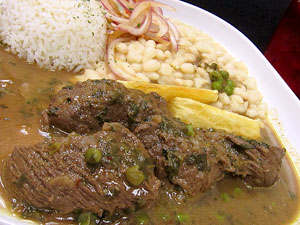 |
||
| Seco de Res | Dominic Armato | |
Refugees from Contigo Peru will probably want to know how I feel Tumi stacks up, and while I'd be lying to myself if I didn't admit that I'll be acutely feeling that loss, this is a preference that isn't completely cut and dried. If my favorite Peruvian joint in town had to close, I have to say that Tumi is a fallback for which I'm supremely grateful. The standards are well-executed, the ingredient sourcing and execution is there, the menu leaves no gaping holes in my personal hit list. I feel like I have to get pretty darn picky to find fault with these dishes. And if Tumi's offerings fall just short of the standard Graham set under his previous employ, I have a hunch that a few more visits and a little more time may change that. While the ceviche or Aji de Gallina make me pine for my previous favorite, I'm delighted by dishes like the Papa Rellena or Anticuchos, which I think are stronger here. Plus, delicious hits like the Seco de Res give me hope that there are still some serious gems on Tumi's menu that I've yet to discover. Most certainly, I'll be back, as Tumi is now unquestionably the local Peruvian restaurant about which I get the most excited.
| Tumi Fine Peruvian Cuisine | |
| www.tumi-restaurant.com | |
| 2160 N. Alma School Road | |
| Chandler, AZ 85224 | |
| 480-821-1717 | |
| Tue - Sat | 11:30 AM - 9 PM |
| Sun | 11:30 AM - 8 PM |

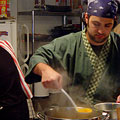
Comments